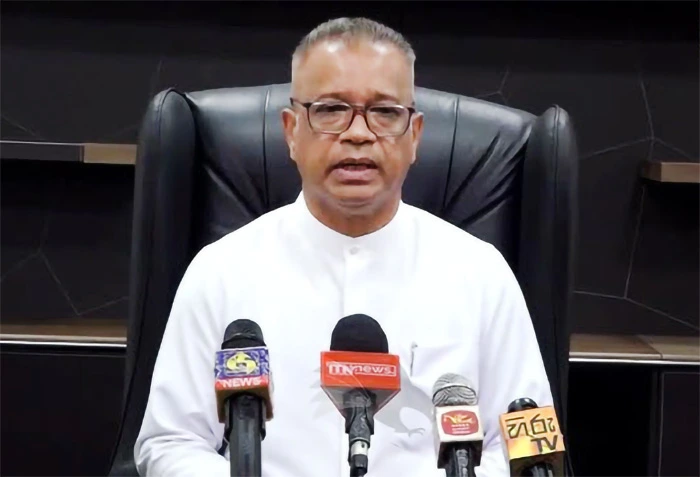By Rathindra Kuruwita
Minister of Agriculture, Livestock, Lands, and Irrigation K. D. Lalkantha’s recent statement that there are no legal restrictions on taking measures against wildlife that damage crops on private agricultural lands encourages farmers to violate the law, says Sajeewa Chamikara of the Movement for Land and Agricultural Reform (MONLAR).
Chamikara noted that such remarks undermined the principles outlined in the government policy declaration “A Prosperous Country, A Beautiful Life,” which emphasises fostering responsible citizens, developing human resources, and upholding the rule of law. “This shows that government Ministers are disregarding these principles. The legislative power granted to the government by the people, after the defeat of corrupt and authoritarian regimes in the past, was not intended to enable breaches of agreements made with the public within such a short period,” Chamikara said.
Under Section 53A of the Fauna and Flora Protection Ordinance No. 02 of 1937, as last amended by Act No. 07 of 2022, the use of poisons, explosives, or intoxicants to kill or immobilise wild animals is strictly prohibited. Section 52 of the Act further makes it illegal to use artificial lighting to dazzle or lure animals or to act in a way that facilitates their capture.
“Additionally, Section 52A prohibits the use of food items, scents, colours, or any material or device to attract or entice animals for capture. Section 53A also forbids the possession of any animal killed or captured using poisons, explosives, or intoxicants,” Chamikara said.
According to Section 58, individuals guilty of such offences face penalties of fines between Rs. 15,000 and Rs. 30,000, imprisonment for one to two years, or both. Section 59 clarifies that anyone who attempts or abets the commission of these offences is equally culpable and subject to the same penalties.
Chamikara warned that if Minister Lalkantha’s suggestion to control wild animals on private agricultural lands like other agricultural pests is acted upon, it would result in direct violations of the Fauna and Flora Protection Ordinance, carrying severe penalties. “By encouraging farmers to engage in illegal activities, the Minister has effectively facilitated potential breaches of the law,” he said.
Under Section 59 of the Act, legal action could also be taken against Minister Lalkantha for abetting these offences. “Ignorance of the law is no excuse, a principle that applies equally to the Minister. Moreover, misleading farmers constitutes a significant injustice that warrants accountability,” he added.
Chamikara said that crop damage by wild animals is not only a legal fact but also common knowledge, and the underlying causes of this behaviour are well understood. “Wild animals have been forced into these situations due to human actions, such as the destruction and fragmentation of natural ecosystems for human settlements, commercial agricultural lands, and development projects. The introduction of non-native plantations like acacia, pine, eucalyptus, and teak, along with the spread of monoculture crops such as tea, rubber, coconut, oil palm, and maize, have exacerbated the issue. Additionally, invasive plants such as giant mimosa, lantana, and thorny creepers have proliferated in natural habitats, providing neither food nor shelter for wildlife,” he said.
These factors, Chamikara said, have caused species like monkeys, toque macaques, porcupines, wild boars, and peacocks to lose their habitats and foraging grounds, forcing them onto agricultural lands. He added that the reduction and fragmentation of natural habitats have also limited natural predators, leading to population increases in these species.
“In response, Schedule I of the Fauna and Flora Protection Ordinance designates certain mammals, including monkeys, toque macaques, wild boars, porcupines, and hares, as non-protected due to their status as agricultural pests. Similarly, Schedule III lists non-protected birds such as the Indian nightjar, crows, feral pigeons, spotted doves, and white-backed munias,” Chamikara said.
However, these animals and birds are deemed non-protected only within private agricultural lands. Even so, they cannot be controlled using chemicals, poisons, electrical traps, or intoxicants. Their control is permissible only through the use of a licensed firearm, as stipulated by law.
“To better address the issue of crop-damaging species, it is recommended that the Fauna and Flora Protection Ordinance be revised. Species like toque macaques and hares, which contribute minimally to crop damage, should be removed from Schedule I. Instead, more impactful species, such as toque langurs, should be included. Similarly, birds like feral pigeons and white-backed munias could be replaced with peacocks in Schedule III, as they contribute significantly to crop damage. This would ensure that the non-protected lists focus solely on species with substantial impact on agriculture,” Chamikara said.
